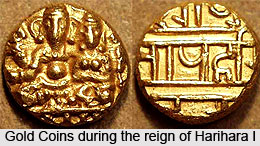 Harihara I had established the empire of Vijayanagara and was also referred to as `Hakka` or `Vira Harihara`. He was the eldest son of Bhavana Sangama and was one of the descendants of the Kuruba clan.
Harihara I had established the empire of Vijayanagara and was also referred to as `Hakka` or `Vira Harihara`. He was the eldest son of Bhavana Sangama and was one of the descendants of the Kuruba clan.
He had also founded the Sangama Dynasty. Following his accession to power, he had created a fort at Barkuru on the western coast which constitutes the modern-day Karnataka. In 1343, he ruled the northern parts of the Hoysala Empire prior to assuming control over the kingdom, after the demise of Hoysala Veera Ballala III. Harihara I was known as `Karnataka Vidya Vilas`, `Arirayavibhada` or fire to enemy kings and `Bhashegetappuvarayaraganda` or punisher of feudal lords who failed to keep their promises according to the inscriptions which belonged to his time.
Kampana controlled the area of Nellur, Marappa governed Chandragati and Muddppa supervised the region of Mulabagalu. His military conquests included the valley of Tungabhadra River and his territories extended to the Malabar Coast and Konkan Coast. During that time, Veera Ballala III had died in a war against the Sultan of Madurai. This incident helped Harihara I to emerge into a powerful ruler since the whole kingdom of the Hoysalas slipped into his rule. An ancient inscription belonging to 1346 stated that the capital of Harihara I was `Vidya Nagara` or the city of learning. The inscription also added that he was the ruler of the region expanding between the western and eastern seas. He had founded an administrative system which ensured peace and prosperity to his subjects. Bukka I was the successor of Harihara I and was one of the most famous rulers of the Sangama dynasty.
This article is a stub. You can enrich by adding more information to it. Send your Write Up to content@indianetzone.com



















